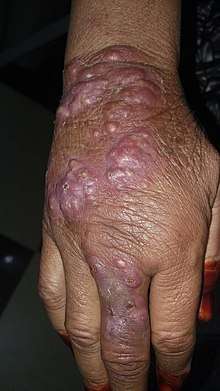Post-kala-azar dermal leishmaniasis
Post-kala-azar dermal leishmaniasis (PKDL) is a complication of visceral leishmaniasis (VL); it is characterised by a macular, maculopapular, and nodular rash in a patient who has recovered from VL and who is otherwise well. The rash usually starts around the mouth from where it spreads to other parts of the body depending on severity.

Post-kala-azar dermal leishmaniasis (also known as "Post-kala-azar dermatosis") found mainly on the face, arms, and upper part of the trunk. It occurs years (in the Indian variation) or a few months(in the African strain) after the successful treatment of visceral leishmaniasis.
It is mainly seen in Sudan and India where it follows treated VL in 50% and 5-10% of cases, respectively. Thus, it is largely restricted to areas where Leishmania donovani is the causative parasite. The interval at which PKDL follows VL is 0–6 months in Sudan and 2–3 years in India. PKDL probably has an important role in interepidemic periods of VL, acting as a reservoir for parasites.
PKDL was first identified by Sir Upendranath Brahmachari, who initially called it dermal leishmanoid. He published his observations in the Indian Medical Gazette in 1922.[1]
Mechanism
The cause of PKDL is uncertain.[2] Possibilities may include use of antimonial drugs, sunburn, reinfection with kala-azar, memory T cell responses failing in certain organs; and genetic susceptibility.[2]
There is increasing evidence that the pathogenesis is largely immunologically mediated; high concentrations of interleukin 10 in the peripheral blood of VL patients predict the development of PKDL. During VL, interferon gamma is not produced by peripheral blood mononuclear cells (PBMC). After treatment of VL, PBMCs start producing interferon gamma, which coincides with the appearance of PKDL lesions due to interferon-gamma-producing cells causing skin inflammation as a reaction to persisting parasites in the skin.
Diagnosis
PKDL is difficult to diagnose.[3]
Diagnosis is mainly clinical, but parasites can be seen by microscopy in smears with limited sensitivity.[3] PCR and monoclonal antibodies may detect parasites in more than 80% of cases. Serological tests and the leishmanin skin test are of limited value.
Treatment
Treatment is always needed in Indian PKDL; in Sudan, most cases are self-limited but severe and chronic cases are treated. Sodium stibogluconate is given at 20 mg/kg for 2 months in Sudan and for 4 months in India. Liposomal amphotericine B seems effective. Although research has brought many new insights in pathogenesis and management of PKDL, several issues in particular in relation to control remain unsolved and deserve urgent attention.
Miltefosine is the only available oral medication available for VL and PKDL.[4] While the drug works for short term treatment of VL, PKDL would require a longer treatment of more than 28 days with this drug.[4] Miltefosine is not recommended for use as a monotherapy to treat PKDL.[4]
Society and culture
People with PKDL are a reservoir of leishmaniasis.[5] To eliminate leishmaniasis from a population, people with PKDL must get treatment.[5]
The government of India has an kala-azar elimination program ongoing which entered a consolidation phase in 2017.[6]
See also
- List of cutaneous conditions
References
- Brahmachari, U. N. (April 1922). "A New Form of Cutaneous Leishmaniasis—Dermal Leishmanoid". The Indian Medical Gazette. 57 (4): 125–127. ISSN 0019-5863. PMC 5186533. PMID 29008368.
- Mukhopadhyay, D; Dalton, JE; Kaye, PM; Chatterjee, M (February 2014). "Post kala-azar dermal leishmaniasis: an unresolved mystery". Trends in Parasitology. 30 (2): 65–74. doi:10.1016/j.pt.2013.12.004. PMC 3919212. PMID 24388776.
- Zijlstra, EE (2019). "Biomarkers in Post-kala-azar Dermal Leishmaniasis". Frontiers in Cellular and Infection Microbiology. 9: 228. doi:10.3389/fcimb.2019.00228. PMC 6685405. PMID 31417876.
- Pijpers, J; den Boer, ML; Essink, DR; Ritmeijer, K (February 2019). "The safety and efficacy of miltefosine in the long-term treatment of post-kala-azar dermal leishmaniasis in South Asia - A review and meta-analysis". PLoS Neglected Tropical Diseases. 13 (2): e0007173. doi:10.1371/journal.pntd.0007173. PMC 6386412. PMID 30742620.
- Ganguly, S; Das, NK; Barbhuiya, JN; Chatterjee, M (August 2010). "Post-kala-azar dermal leishmaniasis--an overview". International Journal of Dermatology. 49 (8): 921–31. doi:10.1111/j.1365-4632.2010.04558.x. PMID 21128917.
- Zijlstra, EE; Alves, F; Rijal, S; Arana, B; Alvar, J (November 2017). "Post-kala-azar dermal leishmaniasis in the Indian subcontinent: A threat to the South-East Asia Region Kala-azar Elimination Programme". PLoS Neglected Tropical Diseases. 11 (11): e0005877. doi:10.1371/journal.pntd.0005877. PMC 5689828. PMID 29145397.